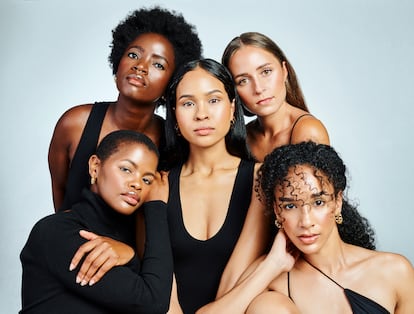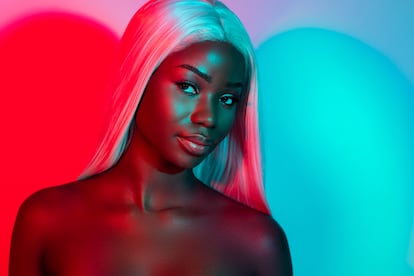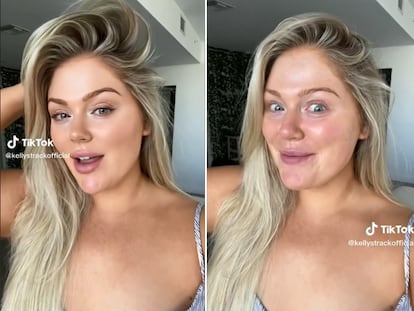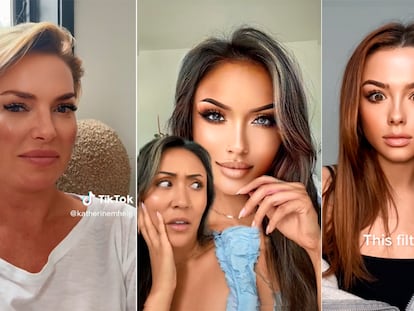Glow skin: Why the post-pandemic era and TikTok have relegated contouring to the past
Faux radiant skin is on-trend and the dense makeup techniques driven by Instagram are now less fashionable

To glow or shine is, according to the dictionary, to emit light. But it can also refer to a person excelling in talent or beauty. Now, glow skin has become the latest obsession among social network users with the beauty and cosmetics industry jumping on the bandwagon and promoting everything from vitamin cocktails to highlighters that promise the desired effect.
Glow skin is also the antithesis of the makeup and facial care trends that triumphed last decade when contouring reached its peak. This heavy makeup technique that was trending thanks to the Kardashians and Instagram, consisted of covering flaws and enhancing the parts our faces we like through the use of color and shadow. Now glow skin represents a promise of radiating light rather than anything concrete.
“The glow effect is closely linked to the idea of youth and freshness,” says Hillary Belzer, founder and curator of the Makeup Museum in Baltimore, US, a space dedicated to the preservation, research and exhibition of cosmetics from antiquity to the 21st century. “There are two fundamental aspects that have caused the trend to go viral in recent years: the first is the negative effect anti-aging labels have on cosmetic products.” At a time when female empowerment also serves to sell products, the beauty industry can no longer afford to suggest aging as something negative, so it looks for terms that promise the same anti-aging effect, such as “youthful radiance.”
The second aspect has to do with the impact of the pandemic and the growing interest in health, which in terms of beauty means a quest for a healthy look: “Glow is also related to health and vitality, since it represents the opposite of being sick, tired and looking like you’ve been cooped up indoors all day,” says Belzer.
Historian Laura Fitzachary, who specializes in the history and evolution of cosmetics, agrees: “On the one hand, there is the growing interest in a healthy lifestyle post pandemic, which means eating better, exercising, and getting the necessary hours of sleep, which, in turn, means a corresponding aesthetic,” she says. “In the end, there is no greater glow than the one we have after doing exercise in the morning.” But Fitzachary also says the emergence of teleworking in the “new normal” and the change to our pace of life have reduced the ‘need’ for thick make-up, more appropriate to nightlife. “Why spend 45 minutes contouring if you’re only going to have a 10-minute Zoom call that day during which you might not even have to turn on the camera?” she says.

If contouring was born out of Instagram’s culture of perfection and aspiration, the glow skin trend is similarly linked to screens and looking at oneself through a lens, though with a philosophy more typical of TikTok which favors a more realistic look, and rewards spontaneity and naturalness, both in form and content. “Contouring was a technique that looked great in photos, but not so great in videos,” says Belzer. “The glow skin trend accommodates movement better and is also easier to create.” On TikTok, overly edited videos are less successful than those that look more natural. The idyllic face on Instagram is a far cry from the desirable face on TikTok.
Both experts believe that the overuse of filters and dense makeup techniques pre-pandemic completely ignored the actual look of natural skin with its wrinkles, fine lines, redness, blemishes and other imperfections: “High-definition photography brought us makeup techniques that blurred or covered up any skin texture,” says Fitzachary.
There are many products associated with glow skin, such as Vaseline, traditionally used in film and fashion photography; blusher, responsible for bringing that natural flush to the cheeks; facial oils or illuminators. But, undoubtedly, one of the great precursors of this trend in the West has been the emergence of the Korean 10-step beauty routine that brought us trends such as Dolphin skin or glass skin: “In Asian countries, a tradition that still holds today is ‘skin first, makeup second.’ In Western countries, perhaps with the sole exception of France, the trend has been the other way around,” says Belzer. “However, now, partly because of internet and partly because of self-care trends, we prefer to take care of our skin first rather than cover it with makeup.”
Glow has always been desirable. And enormously sought after: “Another moment when there was enormous interest in glow skin was in 1950, when makeup techniques designed to obtain a better result on camera began to be used on the sets of Hollywood films,” says Fitzachary, who believes that many cosmetic trends were associated with screens prior to social media. “There is a text from 1858 signed by Lola Montez, Countess of Landsfeld, in which she said that ‘glow is the finishing touch of every good lady.’ To achieve that glow, the Countess recommended ‘temperance, exercise and grooming,’ just like the influencers we see now on TikTok with their healthy lifestyle tips.”
Sign up for our weekly newsletter to get more English-language news coverage from EL PAÍS USA Edition
Tu suscripción se está usando en otro dispositivo
¿Quieres añadir otro usuario a tu suscripción?
Si continúas leyendo en este dispositivo, no se podrá leer en el otro.
FlechaTu suscripción se está usando en otro dispositivo y solo puedes acceder a EL PAÍS desde un dispositivo a la vez.
Si quieres compartir tu cuenta, cambia tu suscripción a la modalidad Premium, así podrás añadir otro usuario. Cada uno accederá con su propia cuenta de email, lo que os permitirá personalizar vuestra experiencia en EL PAÍS.
¿Tienes una suscripción de empresa? Accede aquí para contratar más cuentas.
En el caso de no saber quién está usando tu cuenta, te recomendamos cambiar tu contraseña aquí.
Si decides continuar compartiendo tu cuenta, este mensaje se mostrará en tu dispositivo y en el de la otra persona que está usando tu cuenta de forma indefinida, afectando a tu experiencia de lectura. Puedes consultar aquí los términos y condiciones de la suscripción digital.
More information
Archived In
Últimas noticias
The metaverse, four years later: Is it finished or just at a standstill?
$3,000 and a plane ticket: The United States increases incentives for migrants to self-deport before the end of the year
Charles Dubouloz, mountaineering star, retires at 36 with a farewell tour inspired by Walter Bonatti
From the White House to diplomatic gifts: Lego wins over adult fans, brick by brick
Most viewed
- The low-cost creative revolution: How technology is making art accessible to everyone
- Families demand repatriation of bodies of Colombians who died in Ukraine: ‘This war is a slaughterhouse for foreigners’
- Christian Louboutin: ‘Young people don’t want to be like their parents. And if their parents wear sneakers, they’re going to look for something else’
- All the effects of gentrification in one corner of Mexico’s Colonia Roma
- Christmas loses its festive spirit: ICE fears cast shadow over religious celebrations











































